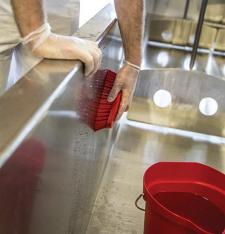Menu


Although assuring food safety should go beyond compliance with governmental regulations, we have created the below checklist to help processors determine if they are in compliance with FDA’s GMPs. If you answer “no” to any of the below questions, take time to review the regulations with your food safety team or contact a food safety professional.
✓ Is food safety and plant sanitation under the direction of more than one competent person?
✓ Is there a person in your facility who is considered a “Preventive Controls Qualified Individual”?
✓ Does your facility have a Master Sanitation Program and Schedule?
✓ Are tools and equipment sufficiently inspected, cleaned, sanitized and stored appropriately before and/or after use, especially when their intended use is in contact with food products?
✓ Are cleaning utensils adequately maintained and stored when not in use in a way that prevents contamination?
✓ Are the chemical cleaning agents present in the facility clearly identified and stored safely in order to not contaminate food, raw materials and end product?
✓ Is condensation satisfactorily controlled from dripping onto equipment and into food products?
✓ Is the facility’s interior, including ceilings, floors and walls, accessible for regular and thorough cleaning?
✓ Are items such as floor pads and paper towels, or other one use disposable items, thrown out without delay after use?
✓ Are all food and non-food contact surfaces and equipment designed to be sufficiently cleaned and inspected on a regular basis?
✓ Is the environment surrounding your facility’s exterior designed to discourage the existence of pests sufficiently?—including adequate drainage, equipment, waste disposal and vegetation.
✓ Is the facility’s ventilation adequate as to not allow contamination from vapors and odors of food, food-packaging materials and food-contact surfaces?
✓ Does the facility’s lighting allow for sufficient examination of food and equipment, and for employees to see posted communications? Is it also in good condition and working order to ensure it does not introduce a physical food safety hazard?
✓ Does the water supply and facility plumbing adequately provide fresh, clean water for daily operations and waste removal?
✓ Are food contact areas covered and/or monitored appropriately to protect against contamination from foreign materials that may be accidentally introduced?
✓ Are all materials coming into contact with food and food contact surfaces approved for this use?
✓ Do you have documentation that proves the tools and equipment intended for food contact use are made with materials that are compliant with FDA Title 21 CFR?
While this is not a comprehensive list for GMP or FSMA Prevent Controls Rules compliance, it can be used as a quick method to check your facility for possible compliance issues. Contact a food safety professional or your Rodem representative to further analyze critical areas of compliance.
**Special thank you to our manufacturing partner Remco Products for providing us with the information for this article. Remco’s content has been adapted from the original with their review and permission. Download Remco Products whitepapers here. Remco and Vikan® brands offer the most tools in the most colors for flexibility in designing comprehensive color-coding systems. Call Rodem for more info on Remco Products.**

E-mail: [email protected]
Copyright 2024 Rodem Inc. All rights reserved.